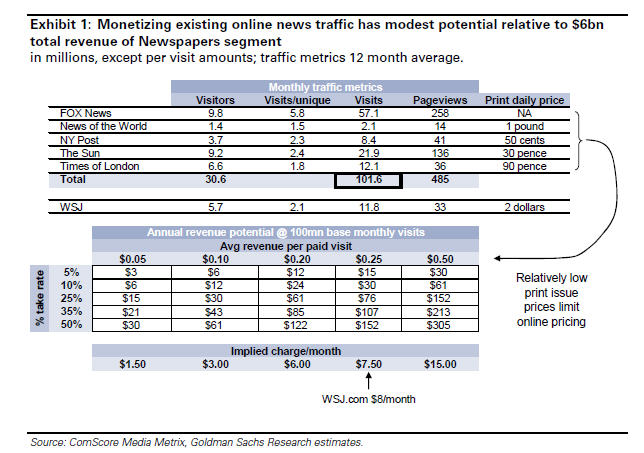Rupert Murdoch's grand subscription plan: Much ado over minimal revenue?

News Corp. chief Rupert Murdoch said that the company will begin charging for its news sites. The details were a bit vague, but Murdoch said News Corp.'s big experiment kicks off in 2010. The larger question is whether this move is much ado about little revenue.
We'll suspend disbelief for a few moments---are you really going to pay anything for the New York Post?---to set the scene. Here's exactly what Murdoch had to say about charging for all news properties on the company's earnings conference call:
Let me specifically address truthfully some of the challenges facing our print businesses. As I always have said before the traditional income and business model has to ensure that our journalistic enterprises can return to their old margins profitability. The extended downturn has only increased the drumbeats of change but the secular challenge is clear. Classified advertising revenues will never again reach the levels that print once offered.
Quality journalism is not cheap and an industry that gives away its content is simply cannibalizing its ability to produce good reporting. The increase we have seen in our Wall Street Journal subscriptions since we acquired the paper proves to me that the market is willing to pay for that quality without any special market.
And we have tens of millions of readers. In Britain, the Times of London has a digital audience that now reaches more than 16.0 million people across the globe every day. In the U.S. the Journal is the only newspaper that has actually expanded both as print and online subscriptions during this recession. Additionally, you can now also read the Journal on your Blackberry or iPod.
We can be platform-neutral but never free. Intense research and development is being done by many companies to produce convenient and inexpensive mobile reading devices. Right now we are working with software, hardware, and other publishers within the industry to develop a model that works for consumers. Beyond the economics, it is crucial we maintain a direct relationship with our customers.
I think that we all are working on different models at the moment, but we're certainly satisfied that we can produce significant revenues, or we're very hopeful we can build significant revenues from the sale of digital delivery of newspapers, news content.
Summary: News Corp. wants to get paid in annual subscriptions or a nickel at a time.
Now Murdoch's riff on charging for news was notable. However, it was also notable how little analysts followed up on it. Why? There's no money there. To Wall Street Murdoch would be better off shutting down some of these print assets. And if you really want to be cynical you could argue that Murdoch's rant was a nice move to deflect from the fact that MySpace is a mess.
So how much money would these various pay news models bring in? Goldman Sachs reckons less than $200 million in incremental revenue. That compares to $6 billion in revenue for News Corp.'s newspaper business.
Goldman Sachs analyst Mark Wienkes walks through some of the math. The biggest problem here is that the Wall Street Journal pay model doesn't work for other papers. The WSJ.com base is used to paying a premium. You pay 50 cents for the New York Post, assuming it just isn't left behind somewhere. What would you pay online for Page Six?
Weinkes sees two models for News Corp. The first is an annual or monthly subscription model. The second is a micropayment model. The latter would be best suited to photos and gossip---in other words the stuff you get from most of News Corp.'s mainstream papers.
Weinkes whipped up this handy graphic in a report that focused mostly on News Corp.'s other businesses (he's following the money):
The big takeaways here:
- Newspapers low pricing in the real world limits what you can charge online.
- The WSJ.com model is a unique case.
- FoxNews.com may not be monetized since it's sourced mostly from AP. You could charge for video.
- Page views will tank and lead to lower ad rates.
Add it up and Weinkes is stating the obvious. The WSJ.com is in a different league than News Corp.'s other print properties. What exactly does News Corp. have that's worth charging for?
Staci Kramer at PaidContent put it best:
Murdoch’s plans include charging for the websites of UK tabloids The Sun and the News of the World U.S. tabloid the New York Post, which already failed with its own celeb site sunk by high expenses, for general newspapers like the Times of London and The Australian. They also include non-print sites like FoxNews.com. What will News Corp. charge for? MIcropayments to see the Sun‘s topless Page 3 girls (or maybe 10p not to see them)? “World exclusive” interviews with 15-second celebs? Bill O’Reilly outtakes?
Good questions indeed. We'll find out next year.
